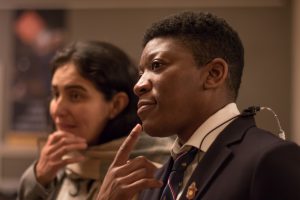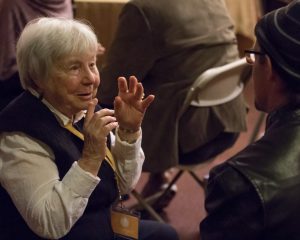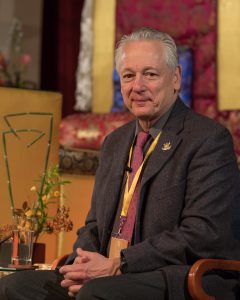Thursday
Sakyong and FamilyRising in the West
Sakyong Mipham energizes Shambhalians in Seattle: “Rising to the Occasion, Social Engagement in a Chaotic World”
by Andrea D’Asaro
 Despite the cold and rain, it was a sold-out crowd that arrived early on Friday night to hear Sakyong Miphan’s calm yet urgent call to action during “this critical time, this poignant moment of crossroads.” His visit to Seattle, entitled “Rising to the Occasion: Social Engagement in a Chaotic World,” encouraged the audience to galvanize their humanity: “Our society is a giant being that’s trying to raise its lungta. We do that by touching our strength, by connecting to another person, by understanding the spirit of humanity, by reaching out beyond only ‘me’.”
Despite the cold and rain, it was a sold-out crowd that arrived early on Friday night to hear Sakyong Miphan’s calm yet urgent call to action during “this critical time, this poignant moment of crossroads.” His visit to Seattle, entitled “Rising to the Occasion: Social Engagement in a Chaotic World,” encouraged the audience to galvanize their humanity: “Our society is a giant being that’s trying to raise its lungta. We do that by touching our strength, by connecting to another person, by understanding the spirit of humanity, by reaching out beyond only ‘me’.”
The avid audience of more than eight hundred senior Buddhists, young seekers, and Shambalians from surrounding Northwest states and Canada, sat silently on 100-year old pews under vaulted ceilings and the central dome of a former church, now known as Town Hall, a community cultural center.
 The Sakyong framed his message of social engagement as an expression of the meditative path, emphasizing how we shape society when we touch our hearts and expand out: “When the little person within us smiles and says, ‘I can do this,’ it’s called lungta or windhorse. In Tibet, when we reach the top of a mountain, we take out our prayer flags and call, ‘ki ki, so so’—‘may the wind carry my intention, my spirit to climb the mountain, my great aspirations.’ When we go forward, this magic arises.”
The Sakyong framed his message of social engagement as an expression of the meditative path, emphasizing how we shape society when we touch our hearts and expand out: “When the little person within us smiles and says, ‘I can do this,’ it’s called lungta or windhorse. In Tibet, when we reach the top of a mountain, we take out our prayer flags and call, ‘ki ki, so so’—‘may the wind carry my intention, my spirit to climb the mountain, my great aspirations.’ When we go forward, this magic arises.”
He encouraged us to participate and engage with family, friends, colleagues, and organizations – to extend ourselves wholeheartedly into all of the complexities of our lives. “How we hold ourselves has a profound impact on how the world moves forward; we must not let others determine our future, we must raise our gaze.”
With references to his father, the Sakyong also affirmed how his lineage inspires him: “I come from a long line of people who struggled. Even in conditions of freezing cold or while herding sheep, they were thinking about the nature of reality. Even in terrible situations of oppression, they took what they had and lifted themselves up. They asked, ‘How am I going to feel my humanity and interconnectedness, the subliminal fabric that creates the environment?’ ”
The uncertainties of this time can challenge us to hold our seats and work with our obstacles: “Chaos can be an opportunity. Out of confusion, birth arises. There’s the chance to look at ourselves with dignity, kindness, and compassion. How we hold ourselves has a profound impact on how the world moves forward.”
 Gesturing towards his heart, the Sakyong emphasized the power of feeling, referring to Shambhala meditation, which he offered at the Saturday daylong workshop. “When we know how we feel, we become multi-dimension beings. This meditation is meant to enliven us, connect with feeling and a sense of vulnerability that is balancing body, mind, and breath.”
Gesturing towards his heart, the Sakyong emphasized the power of feeling, referring to Shambhala meditation, which he offered at the Saturday daylong workshop. “When we know how we feel, we become multi-dimension beings. This meditation is meant to enliven us, connect with feeling and a sense of vulnerability that is balancing body, mind, and breath.”
He left the audience with an encouragement to “wake up tomorrow morning and consider the journey of your life. It’s my deep wish that you reflect on these themes of warriorship, compassion, and bravery. That moment creates the mandala of kings.”
“And good luck on the election Tuesday,” quipped the Sakyong to laughter as he waved goodbye.
The next day, Acharya Fleet Maull led a workshop with 250 Shambhalians from Cascadia, the northwest region that includes Oregon, Washington, and British Columbia. Maull, who directs mindfulness workshops in prisons and police departments, encouraged participants to allow a sense of safety and connectedness. As part of a deep listening and meditation practice with partners, he encouraged the audience to “allow yourself to be seen. When we aren’t seen and heard, shame becomes conflated with vulnerability. Instead, we need to find our safe place from where we can slowly make friends with vulnerability.”
The lower level hall was askew, with hundreds of young and old meditators face to face in pairs, hands on their hearts, leaning in and hearing one another in turn. A rainbow of silent sitters in red, purple, plaid, grey, and white shirts were encouraged to feel their bodies and to “drop into being as a way to help the world, which is trying to hold the space.”
Following the threads of the Sakyong’s talk, Maull encouraged us to reach beyond our usual boundaries as part of the dyad practice: “When we rest in our own openness, we create connections with others. Listen to each other with a soft gaze and a grandmother smile. This moment allows a breeze of delight and basic goodness. You allow your partner to be seen as the most complex, interconnected being in the universe.” Using his expertise in neuroscience, Maull emphasized how our basic mind-body connections work: “We have the choice to be open for communication or closed for survival.”
 As the dyads moved between sharing and silence, the room was alive with vibrancy: an older man with grey stubble gestured as a young woman with red hair listened and nodded. A tall man with a dark beard touched his heart, while a short bald man smiled back at him. The energized buzz of heart sharing filled the room – even navy-clad kasung joined with partners.
As the dyads moved between sharing and silence, the room was alive with vibrancy: an older man with grey stubble gestured as a young woman with red hair listened and nodded. A tall man with a dark beard touched his heart, while a short bald man smiled back at him. The energized buzz of heart sharing filled the room – even navy-clad kasung joined with partners.
“Perhaps it’s our capacity for feeling rather than our skill at thinking that make us fully human,” commented Maull. “Without our heart awareness, we are driven by chasing comfort and avoiding pain rather than rising above and reclaiming our humanity.
Sunday morning saw a gathering of Shambhala leaders—from Alaska to Oregon to British Columbia—to hear a final talk and blessing by the Sakyong. When the Sakyong arrived and sat on his throne, they welcomed him with cries of “ki ki so so.” In his closing message, he encouraged leaders to “step up and manifest, to be present for the conversation, to take the blame or credit for every communication, to look at what’s painful and provide compassion, to be tender or to celebrate, when needed.”
He encouraged leaders to give up hesitation. “We need to muster all the elements on the spot, manifest our own journey of deepening practice. Leadership can be powerful like the moving of the earth, plate tectonics, when the environment demands that you grow. We must find the genuine source of showing up, the innate unconditional strength. We are riding the energy of Shambhala, realizing our own community”
With the Sakyong’s invitation to rise to the occasion, we left the hall tenderly touching that little space inside us: our human heart, our conscious being that we are now more willing to examine, to take responsibility for knowing emotionally, spiritually, deeply.
Photos by: Jason Ruvelson www.jasru.com JASRU Photography

















